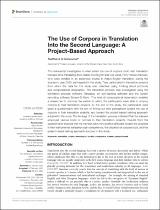| dc.contributor.author | Mohammed, Tawffeek A. S. | |
| dc.date.accessioned | 2022-07-04T09:39:48Z | |
| dc.date.available | 2022-07-04T09:39:48Z | |
| dc.date.issued | 2022 | |
| dc.identifier.citation | Mohammed, T. A. S. (2022). The use of corpora in translation into the second language: A project-based approach. Frontiers in Education, 7, 849056. 10.3389/feduc.2022.849056 | en_US |
| dc.identifier.issn | 2504-284X | |
| dc.identifier.uri | https://doi.org/10.3389/feduc.2022.849056 | |
| dc.identifier.uri | http://hdl.handle.net/10566/7547 | |
| dc.description.abstract | This manuscript investigates to what extent the use of corpora could help translation
trainees while translating from Arabic into English and vice versa. Forty Yemeni trainees,
who were enrolled in an advanced course in Arabic-English translation during the
academic year 2020, participated in the study. They participated in translation projects
from which the data for this study was collected, using thinking aloud protocols
and computational observation. The translation process was investigated using the
translation process software Transalog, an eye-tracking software and the screen
recording software Screen-O-Matic. This kind of computational observation enabled
a researcher to discover the extent to which the participants were able to employ
corpora in their translation projects. | en_US |
| dc.language.iso | en | en_US |
| dc.publisher | Frontiers Media | en_US |
| dc.subject | Translation | en_US |
| dc.subject | Corpus | en_US |
| dc.subject | Monolingual | en_US |
| dc.subject | Trainees | en_US |
| dc.subject | Second language | en_US |
| dc.title | The use of corpora in translation into the second language: A project-based approach | en_US |
| dc.type | Article | en_US |

